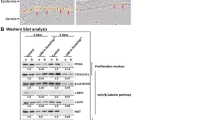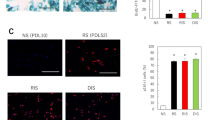Summary
Amiprilose hydrochloride has been shown to inhibit the proliferation of a number of hyperproliferative cell types including psoriatic skin cells. In the present study, the effects of amiprilose hydrochloride on human tissue equivalents were examined by incubating a) dermal equivalents, b) skin equivalents in the process of epidermalization, and c) mature skin equivalents, with varying concentrations of the drug. In all three models amiprilose hydrochloride concentrations of 0.1% (wt/vol) and lower were not toxic to fibroblasts and keratinocytes and did not interfere with the differentiation of the skin equivalent and the developing skin equivalent. When tested in dermal equivalents, concentrations of amiprilose hydrochloride between 0.1 and 0.5% resulted in changes in fibroblast morphology with development of large intracellular vacuoles, and concentrations greater than 5% were toxic. In mature skin equivalents, in addition to changes in fibroblast morphology, amiprilose hydrochloride in concentrations of 1 to 10% affected the epidermis. When 0.5% amiprilose hydrochloride was present in the developing skin equivalent during differentiation, the epidermal keratinocytes were also affected. Thus the morphology of basal keratinocytes was modified, the differentiation was incomplete, and the dermalepidermal attachment was compromised. These studies suggest the possibility of an extracellular mechanism of action of amiprilose hydrochloride and delineate acceptable dosage ranges for the potential drug.
Similar content being viewed by others
References
Asselineau, D.; Bernard, B. A.; Bailly, C., et al. Epidermal morphogenesis and induction of the 67K keratin polypeptide by culture of human keratinocytes at the liquid-air interface. Exp. Cell Res. 159:536–539;1985.
Asselineau, D.; Bernard, B.; Bailly, C., et al. Human epidermis reconstructed by culture: is it “normal?” J. Invest. Dermatol. 86:181–186; 1986.
Ayoub, P.; Shklar, G. A modification of the mallory connective tissue stain as a stain for keratin. Oral Surg. 16:580–581; 1963.
Bell, E.; Ehrlich, H. P.; Sher, S., et al. Development and use of a living skin equivalent. J. Plast. Reconstr. Surg. 67:386–392; 1981.
Bell, E.; Sher, S.; Hull, B., et al. The reconstitution of living skin. J. Invest. Dermatol. 81:2–10s; 1983.
Bernstam, L. I.; Vaughan, F. L.; Bernsteinn, I. A. Keratinocytes grown at the air-liquid interface. In Vitro Cell. Dev. Biol. 22:695–705; 1986.
Brinckerhoff, C. E. Decreased cell proliferation and PGE2 production by fibroblasts treated with a modified hexose sugar, Amiprilose hydrochloride (THERAFECTIN®). Agents Actions. 30:322–328; 1990.
Chapman, M. L.; Dimitrijevich, S. D.; Hevelone, J. C., et al. Inhibition of psoriatic cell proliferation inin vitro skin models by Amiprilose hydrochloride. In Vitro Cell. Dev. Biol. 26:991–996; 1990.
Coulomb, B.; Saiag, P.; Bell, E., et al. A new method for studying epidermalizationin vitro. Br. J. Dermatol. 114:91–101; 1986.
Coulomb, B.; Dubertet, L.; Merrill, C., et al. The collagen lattice: a model for studying the physiology, biosynthetic function and pharmacology of the skin. Br. J. Dermatol. 111:83–87s; 1984.
Fry, L. Psoriasis. Br. J. Dermatol. 119:445–461; 1988.
Garrett, E. R.; Van Peer, A.; Mahrous, H., et al. Properties, stability assay, and preliminary pharmacokinetics of the immunomodulatory 1,2-O-isopropylidine-3-O[3′-N,N′-dimethylaminonpropy-α-d-glucofuranose hydrochloride. J. Rheumatol. 71:387–395; 1982.
Gordon, P. Anti-inflammatory actions of an immunomodulator: THERAFECTIN® [1,2-O-isopropylidine-3-O-(3′-N,N′-dimethylamino-n-propy)-α-d-glucofuranose HCI]. In: Willoghby, D. A.; Giraud, J. P., eds. Inflammation: mechanism and treatment. Baltimore: University Park Press; 1980:169–180.
Gordon, P.; Kulkarni, S. V. Antiviral effects of 1,2-O isopropylidine-3-O-(3′-N,N′-dimethylamino-n-propy)-α-d-glucofuranose (SM1213). Abstracts of the Annual Meeting American Society of Microbiology 74:265; 1974.
Gracy, R. W.; Yüksel, K. Ü.; Jacobson, T. M., et al. Cellular models and tissue equivalent systems for evaluating the structures and significance of age-modified proteins. In: Kay, M. M. B., ed. Gerontology: Networks aging of cell membranes and molecules. Basel: S. Karger AG. 37:113–127; 1991.
Kieval, R. I.; Young, C. T.; Prohazka, D., et al. Evaluation of a modified hexose sugar, Amiprilose hydrochloride, in experimental models of synovitis. J. Rhematol. 16:67–74; 1989.
Leigh, I. M.; Pulford, K. A.; Ramaekers, F. C. S., et al. Psoriasis: maintenance of an intact monolayer basal cell differentiation compartment in spite of hyperproliferation. Br. J. Dermatol. 113:53–64; 1985.
Morrison, C. J.; Gordon, P.; Hashimoto, T. Enhanced killing ofCandida albicans by cultured peritoneal exhudate cells treated with S. M. 1213 a synthetic immunomodulator. Antimicrob. Agents Chemother. 26:74–77; 1984.
Van Scott, E. J.; Ekel, T. M. Kinetics of hyperplasia in psoriasis. Arch. Dermatol. 88:373–381; 1963.
Author information
Authors and Affiliations
Additional information
Supported in part by research grant AG01274 from the National Institutes of Health, Bethesda, MD, The R. A. Welch Foundation (B0502), The Texas Advanced Technology and Research Program (Wound Healing and Aging no. 2147), and Greenwich Pharmaceuticals, Inc. R. W. G. is the recipient of a MERIT award from the National Institute on Aging, Bethesda, MD.
Rights and permissions
About this article
Cite this article
Hevelone, J.C., Dimitrijevich, S.D. & Gracy, R.W. Effects of amiprilose hydrochloride on the components of human skin equivalents. In Vitro Cell Dev Biol - Animal 27, 387–396 (1991). https://doi.org/10.1007/BF02630958
Received:
Accepted:
Issue Date:
DOI: https://doi.org/10.1007/BF02630958




